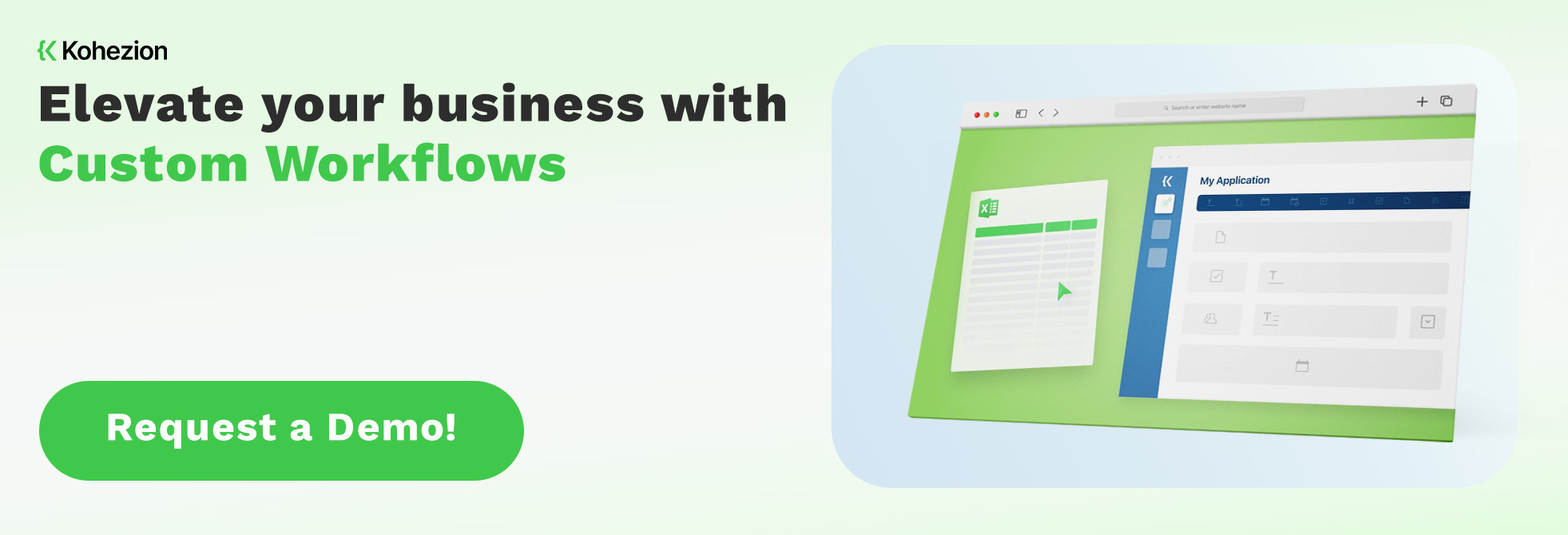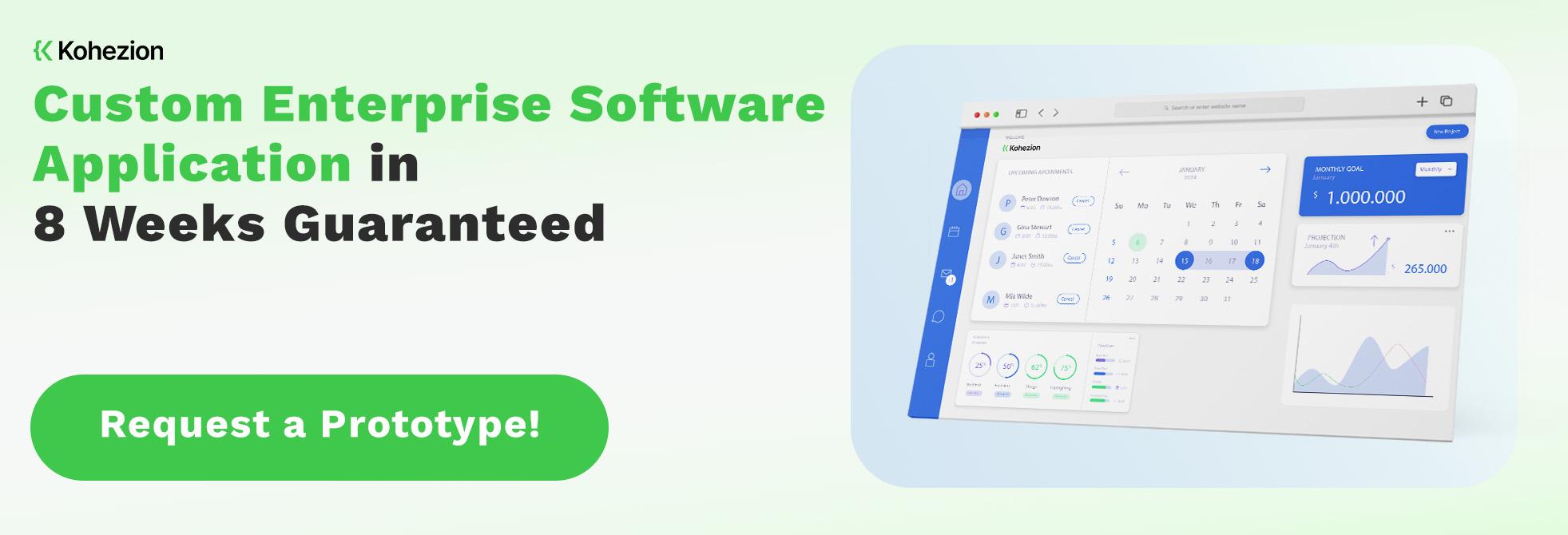This year, the IT industry continues to be shaped by automation, transforming how businesses operate and innovate. Recent statistics show that 73% of IT leaders believe automation is the key to optimizing their operations and maintaining a competitive edge. Whether you're a curious technologist, an IT professional, or a visionary entrepreneur, keeping an eye on the latest trends in IT automation is key to staying ahead. In this blog post, we explore the current IT automation trends that are reshaping the industry.
We'll buid your first application for you. At no extra cost.
Let us build your first business application for free. Go from an idea to an application in under 2 weeks.

Top 10 IT Automation Trends
1. Artificial Intelligence (AI) and Machine Learning (ML)
AI and ML are revolutionizing IT automation with their ability to learn, predict, and act. In 2024, we'll see their applications ranging from chatbots that offer almost human-like customer service to systems capable of anticipating technical issues before they arise. These technologies drive intelligent automation solutions, enabling IT tools to make data-driven decisions and execute complex tasks autonomously.
AI systems can analyze vast amounts of data to make informed decisions, minimizing human error and speeding up processes. AI-driven automation tools can also identify and resolve IT issues without human intervention, saving significant time and reducing expenses. On the other hand, ML algorithms predict future trends and behaviors, allowing organizations to be proactive rather than reactive.
These AI/ML integrations are expected to boost the intelligent automation market, improve the effectiveness and efficiency of IT operations, and become an essential component of digital transformation strategies. The growth of AutoML, which simplifies the application of ML, is expected to skyrocket, helping data scientists to increase productivity. ML will continue to mature in test automation practices, refining tasks such as test case generation and execution.
2. Cloud Automation
As businesses increasingly migrate to the cloud, they look for tools and methodologies to streamline their cloud assets' deployment, management, and scaling. The adoption of Infrastructure as Code (IaC) has become a norm, allowing teams to manage infrastructure using code, making the process faster and repeatable, whereas advanced orchestration tools simplify the management of complex, multi-cloud environments. Growth in implementing cloud automation solutions drives the market size, with projections to reach $207.63 billion by 2027.
In 2024, cloud automation will help organizations increase efficiency, reduce costs, and deliver faster services. Cloud automation helps eliminate the grunt work, allowing IT teams to focus on strategic activities. Automating repetitive tasks reduces the chance of human error, leading to more reliable cloud environments. It also enables dynamic resource allocation based on real-time demand, ensuring optimal performance.
3. IT Service Management Systems
IT Service Management (ITSM) systems are at the core of an organization's IT operations, laying the groundwork for delivering IT as a service. In 2024, the focus on ITSM automation is substantial, accounting for nearly half of all IT automation. The ITSM market is expected to grow from $10.5 billion in 2023 to $22.1 billion by 2028.
ITSM systems improve service delivery, incident response, and asset management. Customers and employees can resolve their issues fast and without IT intervention, thanks to AI-powered knowledge bases and chatbots. Machine learning algorithms can categorize, prioritize, and route tickets efficiently, leading to even faster resolutions. Businesses using ITSM automation report increased customer and employee satisfaction, resulting from decreased downtime and quicker issue resolution.
4. No-Code/Low-Code Automation
No-code/low-code automation allows even those with little to no coding experience to create robust automation solutions. This trend is particularly impactful in 2024, enabling fast development and deployment of applications needed for businesses to stay agile and competitive. According to Gartner, 70% of new applications developed by enterprises will use low-code or no-code technologies by 2025.
Drag-and-drop interfaces and pre-built templates simplify the creation of applications and workflows, reducing dependency on IT personnel. These platforms lower the entry barrier to application development, encouraging innovation at all levels of the organization. Solutions are created and iterated upon quickly, offering a competitive edge in responsiveness.
5. Quality Automation
Quality Automation leverages automation tools to oversee different aspects of quality assurance, such as testing, performance monitoring, and compliance checks. This IT automation trend is witnessing significant growth in 2024 and is expected to continue. According to research, the automation testing market will grow to $55.2 billion by 2028.
Incorporating AI and ML into automated testing tools has led to smarter test case generation and predictive analytics, detecting potential issues ahead of time. Repetitive and time-consuming testing processes are automated, resulting in increased accuracy and faster release cycles. Quality automation is also integral to CI/CD pipelines, ensuring new updates pass quality checks before deployment.
Integrating quality automation helps companies improve their product quality, gain a strategic advantage, and increase customer satisfaction. However, it must be noted that despite all the advancements, teams still need to validate the output to ensure the accuracy and integrity of their systems.
6. Process Automation
In 2024, process automation will continue to enable operational efficiency, taking on repetitive and rule-based tasks, and allowing employees to engage in more strategic and creative activities. Process automation integrates seamlessly across different business systems, ensuring smooth workflows and precision. Integration with APIs and existing business systems means that automation can be embedded into the core of business processes without causing significant disruptions.
Streamlining business processes, from employee onboarding to customer service, reduces bottlenecks and speeds up task completion. Businesses adopting process automation can save up to 60% as a result of reduced operational expenses and increased productivity. Also, improved compliance and reduced error rates improve business quality and customer satisfaction.
7. Infrastructure Automation
Automation has become increasingly important in managing IT infrastructure, contributing to greater scalability, security, and efficiency in managing hardware and software resources. Gartner predicts that by 2025, 70% of enterprises will implement structured infrastructure automation, a 3.5x increase from 20% in 2021.
Treating infrastructure setup and changes with the same approach as software development has revolutionized provisioning and management. Adopting containerization and orchestration tools allows for smoother application deployment, scaling, and operation across different environments. On the other hand, collaboration tools for DevOps teams facilitate better version control and compliance, ensuring consistent environments from development to production. Automated monitoring tools detect and resolve issues autonomously, keeping systems robust and reducing downtime.
Automated patch management and security configurations ensure compliance and security standards are met consistently, reducing the chance of human error. Resource utilization is optimized with dynamic provisioning that can scale up or down based on real-time demand, preventing waste and reducing costs.
8. Software Development Lifecycle
Software Development Lifecycle (SDLC) automation represents the consolidation of different automated processes throughout the stages of software development. It encompasses everything from planning and coding to testing, deployment, and maintenance. The goal is to make the entire lifecycle more efficient, predictable, and scalable.
Continuous Integration and Continuous Deployment (CI/CD) pipelines are maturing, allowing a seamless transition from code to production. Another noteworthy development is the rise of GitOps, an operational framework that applies DevOps best practices for application development to infrastructure automation.
AI-powered tools point out potential issues and suggest optimizations before the code is merged. On the other hand, the stronger bond between development and operations resulting from automation reduces silos and improves collaboration.
The shorter development cycles that result from automated processes speed up time-to-market and responsiveness to market changes. The risk of human error is significantly reduced in repetitive tasks, leading to higher-quality outputs and a more stable final product.
The global DevOps market, which is integral to SDLC automation, is expected to grow to $25.5 billion by 2028, underscoring the adoption rate of lifecycle automation.
9. Agile Methodologies
Agile methodologies remain firmly established within the IT sector in 2024 as organizations continue to embrace its principles for efficient project management and software development. Agile testing strategies like shift-left testing have become more prevalent, introducing quality assurance earlier in the development lifecycle.
The rise of remote work has further underscored the need for Agile frameworks, as they facilitate better communication and coordination among distributed teams. Agile's iterative approach aligns perfectly with the continuous integration and deployment practices that are central to CI/CD pipelines.
Reports indicate that Agile projects are 28% more successful than traditional projects. This is because Agile teams prioritize flexibility, delivering work in small increments that are regularly reviewed and adapted based on feedback. These methodologies are characterized by cross-functional collaboration, breaking down silos, and encouraging a collective approach to problem-solving.
10. Business Process Automation
Business Process Automation (BPA) optimizes operations across different industries and has become imperative for organizations looking for efficiency, scalability, and competitive advantage.
BPA streamlines complex, multi-step business processes, allowing seamless transitions from one task to the next with minimal human intervention. It also improves transparency, providing clear audit trails and real-time monitoring, which is vital for compliance and governance.
Custom BPA solutions like those enabled by no-code platforms mean that businesses of all sizes can tailor automation to their specific needs, improving their process workflows. AI-powered BPA tools are now better at handling exceptions and making adaptive decisions, making processes even more intelligent and efficient.
Organizations report significant cost reductions of up to 30% after implementing BPA. Another important benefit is improved customer experiences resulting from quicker responses and better service management.
According to research, the BPA market size is expected to reach $19.6 billion by 2026, confirming its growing importance.

Be Ahead of the Curve with Kohezion
With Kohezion, you can get a head start on tomorrow's IT automation trends today. Kohezion is a pioneering platform for customizable database software that provides the tools you need to build no-code applications that fit your unique business needs.
The platform’s versatility and user-friendly interface mean you can incorporate the latest IT automation trends into your workflows, staying growth-oriented and innovative. With Kohezion’s agile development cycle, you can deploy applications quickly and respond to market changes effectively. You can also easily share and manage data across departments, fostering a collaborative and transparent work environment.
Adopting Kohezion’s platform speeds up digital transformation, allowing you to leverage best-in-class IT automation practices for business excellence. Stay innovative with a platform committed to evolving and incorporating cutting-edge technologies that will define the future landscape of IT automation.
Conclusion
Automated solutions are leading the way to innovation. Whether it's AI and ML being used more in daily tasks, cloud automation becoming more common, or the rise of no-code/low-code platforms making development accessible to everyone, these trends show that success in the future will be about being efficient, quick, and adaptable.
Being prepared is important, so be sure you understand these trends and use automation in your plans. This way, you can position your organization to take advantage of technological changes. Automation can improve quality, make development smoother, and change management systems for the better.
Start building with a free account
FAQs About IT Automation Trends in 2023
Hyper-automation is an IT trend combining advanced technologies like AI, ML, RPA, and NLP to automate complex processes that typically require human intervention. It differs from traditional automation by its ability to learn, adapt, and make decisions, increasing its scope and the scale of tasks it can perform.
Low-code/no-code platforms make IT automation more accessible. They enable individuals without extensive programming skills to create and deploy applications quickly, which speeds up digital transformation and fosters a culture of innovation within organizations.
AI enables systems to perform complex tasks autonomously, learn from data, and make decisions with minimal human intervention. In the coming year, its impact is growing as it drives the evolution of intelligent automation across different industries.



